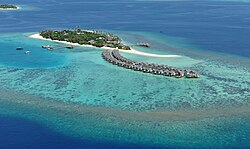Maamigili (Raa Atoll)
| Maamigili | |
|---|---|
| Inhabited island | |

Aerial Shot of Maamigili Island
|
|
| Location in Maldives | |
| Coordinates: 05°40′05″N 72°52′30″E / 5.66806°N 72.87500°ECoordinates: 05°40′05″N 72°52′30″E / 5.66806°N 72.87500°E | |
| Country | Maldives |
| Administrative atoll | Northern Maalhosmadulhu Atoll |
| Distance to Malé | 186.92 km (116.15 mi) |
| Dimensions | |
| • Length | 0.700 km (0.435 mi) |
| • Width | 0.500 km (0.311 mi) |
| Time zone | MST (UTC+05:00) |
Maamigili is one of the inhabited islands of Raa Atoll in Maldives.
The island measures 750 meters in length and 500 meters in width for 100 hectares of pristine coral reef.
Loama Resort Maldives at Maamigili is the hotel accommodation situated on the island. The Resort boasts a collection of historical artifacts at Loama Museum, a nation’s heritage site with ancient baths and wells and the Loama Art Gallery with contemporary local art.
Maamigili can be reached via a scenic 45-minute seaplane ride from the capital Malé and through the new Irufu domestic airport which is 15 minutes away from the island by speed boat.
Loama Museum is the first and only Museum in a Hotel in Maldives licensed under the Government’s Department of Heritage. The young museum collection spans from the Classical to British Colonial Period. Highlights include artefacts found on the island, items of trade and livelihood from the Early Modern or Colonial Period (1514-1828 ) and British Colonial Period (1828- 1965) and an Ancient Bath from the Classical Period (500BCE- 1153), Mausoleum foundations from the Medieval Islamic Period (1153-1514). The museum is located at the hotel lobby and extends to the Ancient Bath and a Traditional House which are located at the heritage site.
Notable exhibits include Chinese porcelain that could have arrived on this island during the Indian Ocean trade between South East Asia and the Middle East. Other interesting artefacts from the collection, representative of the lifestyle and trade that survived inhabitants of these coral atolls for centuries in the middle of the Indian Ocean, include grain measures, coconut oil making and lace equipment.
Vevu (Dhivehi) or bathing tanks, were used as public baths and later for ablution. The actual period of this Vevu is unknown, however sandstone used in construction is evidence pointing to the pre-Islamic period (500BCE-1153AD). The symmetry of the two wells also suggest it may have been part of a temple. These types of baths are found in other parts of Maldives. Coral stone is also seen in some of the baths and mosques. This supports the theory that the Vevu was built earlier than most coral stone mosques. Vevu are constructed by layering sandstone blocks approximately a meter below the water line till about half a meter above ground. There is an octagonal ledge cantilevered at low tide level for people to access the well. According to recorded history, Maamigili has been uninhabited for at least 200 years and during this time the Vevu has been damaged by natural and human interference, yet still it is considered a fine example of a pre-Islamic sandstone structure.
...
Wikipedia

